Spatial Visualisation of Admixture on a Projected Map.
mapmixture
mapmixture is an R package and Shiny app that enables users to visualise admixture as pie charts on a projected map. It also allows users to visualise admixture as traditional structure barplots or facet barplots.
Installation
mapmixture requires R (>= 4.2) to be installed on your system. Click here to download the latest version of R for Windows.
Install the latest stable release from CRAN:
install.packages("mapmixture")
Install the latest development version from GitHub:
# install.packages("devtools")
devtools::install_github("Tom-Jenkins/mapmixture")
Reference
mapmixture() # main function
structure_plot() # plot traditional structure or facet barplot
scatter_plot() # plot PCA or DAPC results
launch_mapmixture() # launch mapmixture Shiny app
Citation
Jenkins TL (2024). mapmixture: an R package and web app for spatial visualisation of admixture and population structure. Molecular Ecology Resources, 24: e13943. DOI: 10.1111/1755-0998.13943.
Examples
Basic usage of mapmixture
Code
# Load package
library(mapmixture)
# Read in admixture file format 1
file <- system.file("extdata", "admixture1.csv", package = "mapmixture")
admixture1 <- read.csv(file)
# Read in coordinates file
file <- system.file("extdata", "coordinates.csv", package = "mapmixture")
coordinates <- read.csv(file)
# Run mapmixture
map1 <- mapmixture(admixture1, coordinates, crs = 3035)
# map1
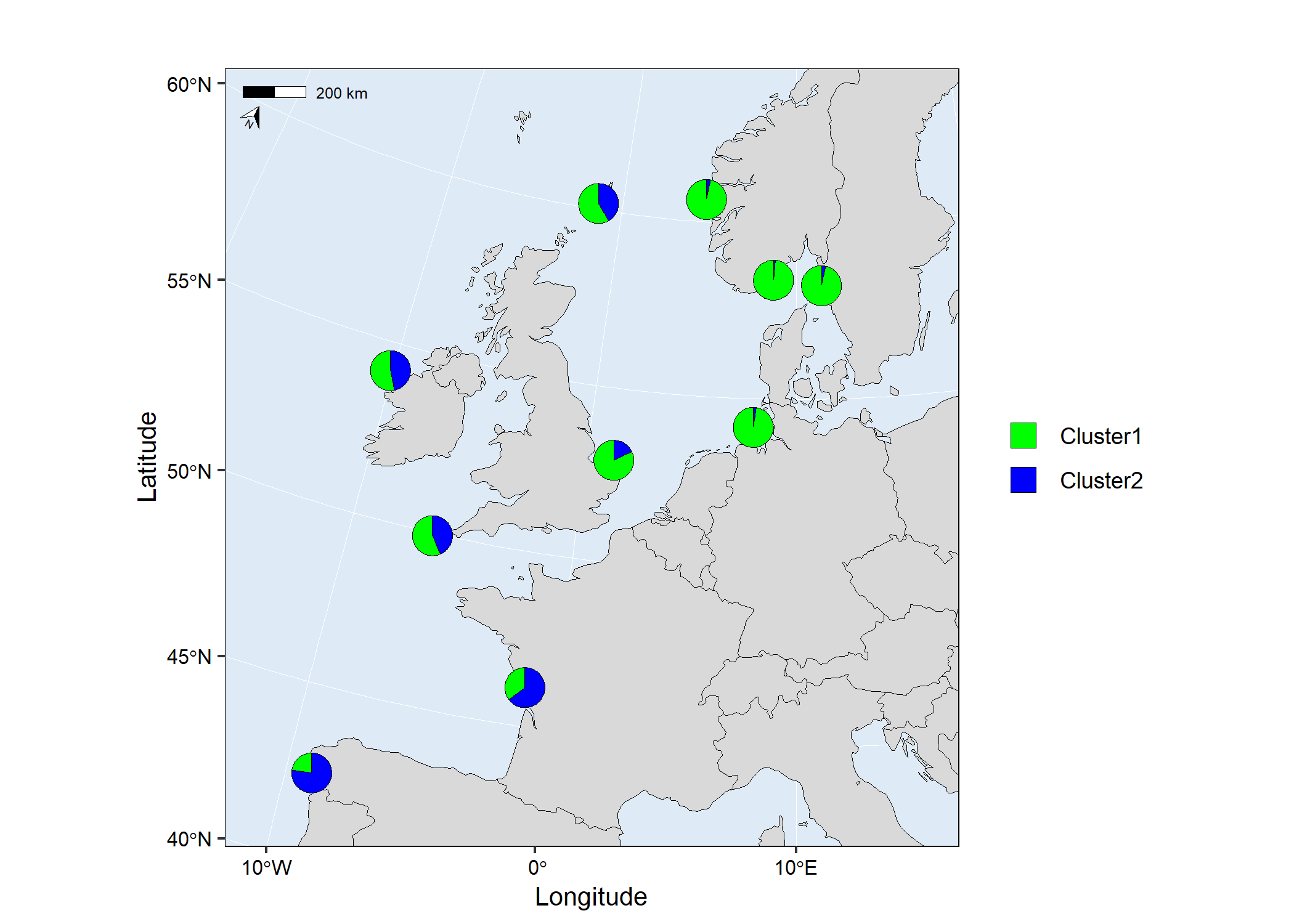
Customised usage of mapmixture with a high resolution map
Code
# Load packages
library(mapmixture)
library(rnaturalearthhires)
# Install rnaturalearthhires package using:
# install.packages("rnaturalearthhires", repos = "https://ropensci.r-universe.dev", type = "source")
# Read in admixture file format 1
file <- system.file("extdata", "admixture1.csv", package = "mapmixture")
admixture1 <- read.csv(file)
# Read in coordinates file
file <- system.file("extdata", "coordinates.csv", package = "mapmixture")
coordinates <- read.csv(file)
# Run mapmixture
map2 <- mapmixture(
admixture_df = admixture1,
coords_df = coordinates,
cluster_cols = c("#f1a340","#998ec3"),
cluster_names = c("Group A","Group B"),
crs = 3035,
basemap = rnaturalearthhires::countries10[, c("geometry")],
boundary = c(xmin=-15, xmax=16, ymin=40, ymax=62),
pie_size = 1,
pie_border = 0.3,
pie_border_col = "white",
pie_opacity = 1,
land_colour = "#d9d9d9",
sea_colour = "#deebf7",
expand = TRUE,
arrow = TRUE,
arrow_size = 1.5,
arrow_position = "bl",
scalebar = TRUE,
scalebar_size = 1.5,
scalebar_position = "tl",
plot_title = "Admixture Map",
plot_title_size = 12,
axis_title_size = 10,
axis_text_size = 8
)
# map2

Admixture map with single coloured circles
Code
# Load package
library(mapmixture)
# Read in admixture file format 3
file <- system.file("extdata", "admixture3.csv", package = "mapmixture")
admixture3 <- read.csv(file)
# Read in coordinates file
file <- system.file("extdata", "coordinates.csv", package = "mapmixture")
coordinates <- read.csv(file)
# Run mapmixture
map3 <- mapmixture(admixture3, coordinates, crs = 3035)
# map3
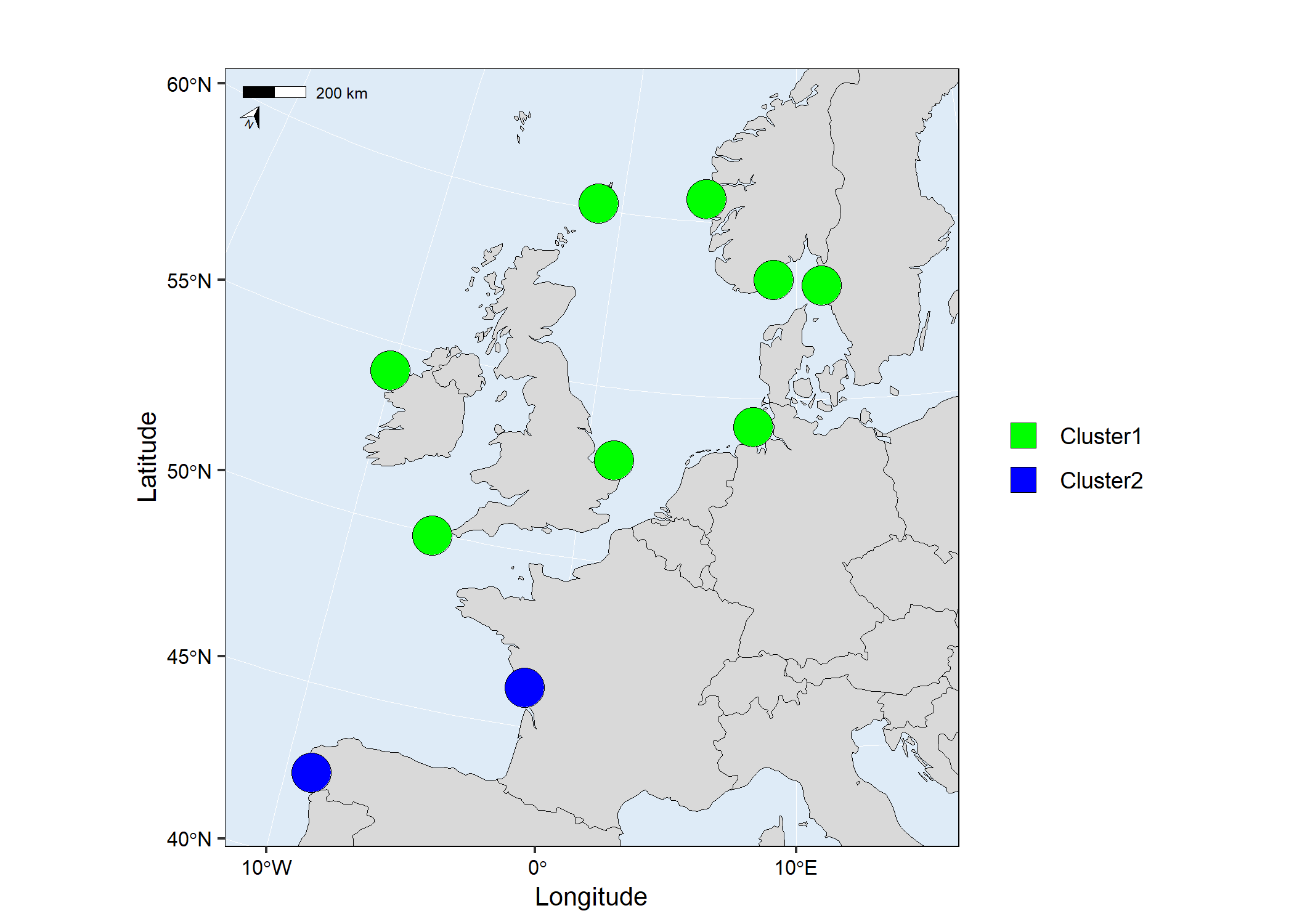
Add additional geoms or theme options to mapmixture ggplot object
Code
# Load packages
library(mapmixture)
library(ggplot2)
# Read in admixture file format 1
file <- system.file("extdata", "admixture1.csv", package = "mapmixture")
admixture1 <- read.csv(file)
# Read in coordinates file
file <- system.file("extdata", "coordinates.csv", package = "mapmixture")
coordinates <- read.csv(file)
# Run mapmixture
map4 <- mapmixture(
admixture_df = admixture1,
coords_df = coordinates,
cluster_cols = c("#f1a340","#998ec3"),
cluster_names = c("Ancestry 1","Ancestry 2"),
crs = 4326,
boundary = c(xmin=-15, xmax=16, ymin=40, ymax=62),
pie_size = 1,
)+
# Add additional label to the map
annotate("label",
x = -10,
y = 46.5,
label = "Atlantic Ocean",
size = 3,
)+
# Add additional text to the map
annotate("text",
x = 2.5,
y = 57,
label = "North Sea",
size = 3,
)+
# Adjust ggplot theme options
theme(
axis.title = element_text(size = 10),
axis.text = element_text(size = 8),
)+
# Adjust the size of the legend keys
guides(fill = guide_legend(override.aes = list(size = 5, alpha = 1)))
# map4
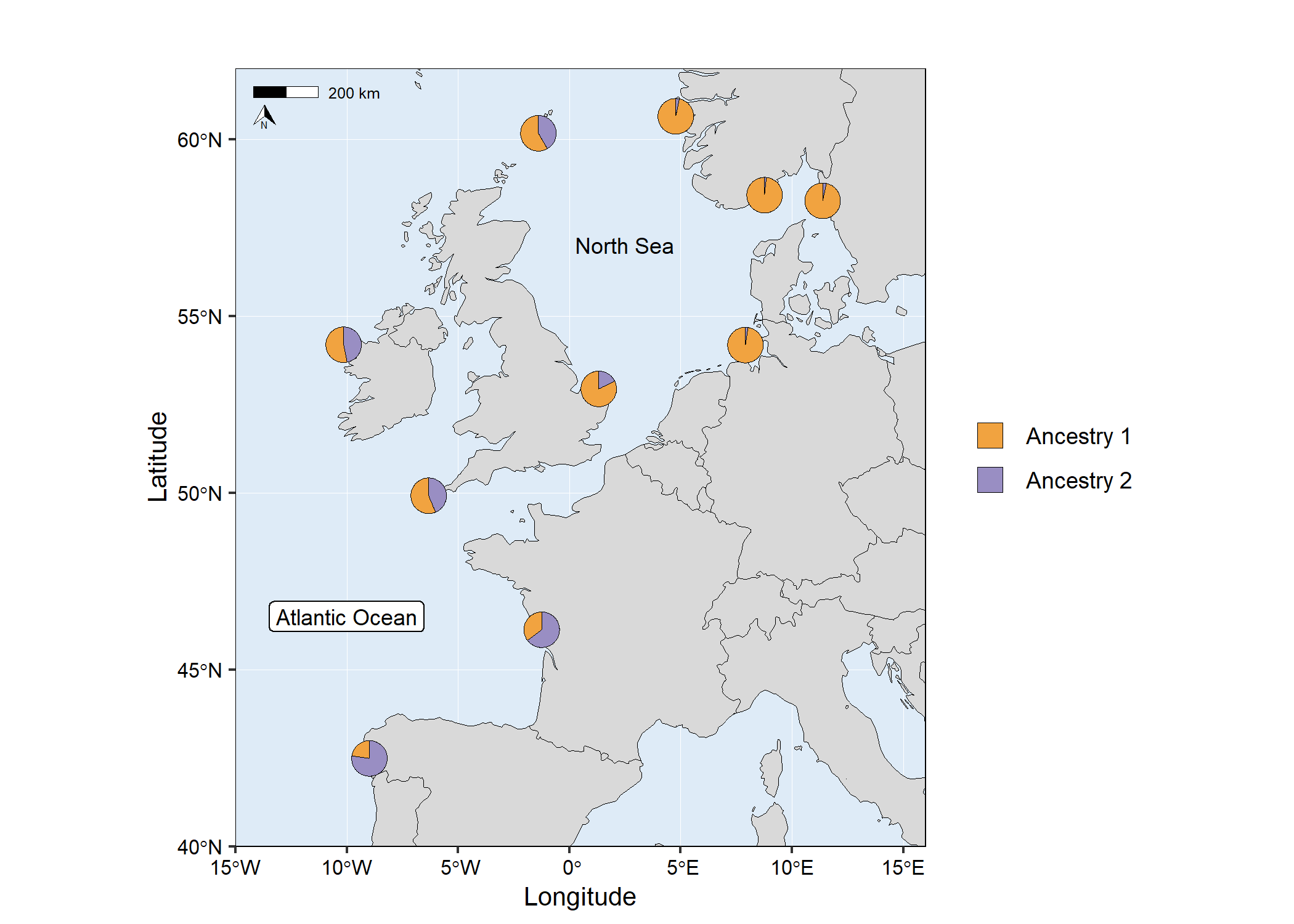
Combine admixture map and barplot ggplot objects into a single figure
Code
# Load packages
library(mapmixture)
library(ggplot2)
library(gridExtra)
# Read in admixture file format 1
file <- system.file("extdata", "admixture1.csv", package = "mapmixture")
admixture1 <- read.csv(file)
# Read in coordinates file
file <- system.file("extdata", "coordinates.csv", package = "mapmixture")
coordinates <- read.csv(file)
# Run mapmixture
map5 <- mapmixture(
admixture_df = admixture1,
coords_df = coordinates,
cluster_cols = c("#f1a340","#998ec3"),
cluster_names = c("Ancestry 1","Ancestry 2"),
crs = 4326,
boundary = c(xmin=-20, xmax=20, ymin=40, ymax=62),
pie_size = 1.3,
)+
# Adjust theme options
theme(
legend.position = "top",
plot.margin = margin(l = 10, r = 10),
)+
# Adjust the size of the legend keys
guides(fill = guide_legend(override.aes = list(size = 5, alpha = 1)))
# Traditional structure barplot
structure_barplot <- structure_plot(
admixture_df = admixture1,
type = "structure",
cluster_cols = c("#f1a340","#998ec3"),
site_dividers = TRUE,
divider_width = 0.4,
site_order = c(
"Vigo","Ile de Re","Isles of Scilly","Mullet Peninsula",
"Shetland","Cromer","Helgoland","Flodevigen","Lysekil","Bergen"
),
labels = "site",
flip_axis = FALSE,
site_ticks_size = -0.05,
site_labels_y = -0.35,
site_labels_size = 2.2
)+
# Adjust theme options
theme(
axis.title.y = element_text(size = 8, hjust = 1),
axis.text.y = element_text(size = 5),
)
# Arrange plots
# grid.arrange(map5, structure_barplot, nrow = 2, heights = c(4,1))
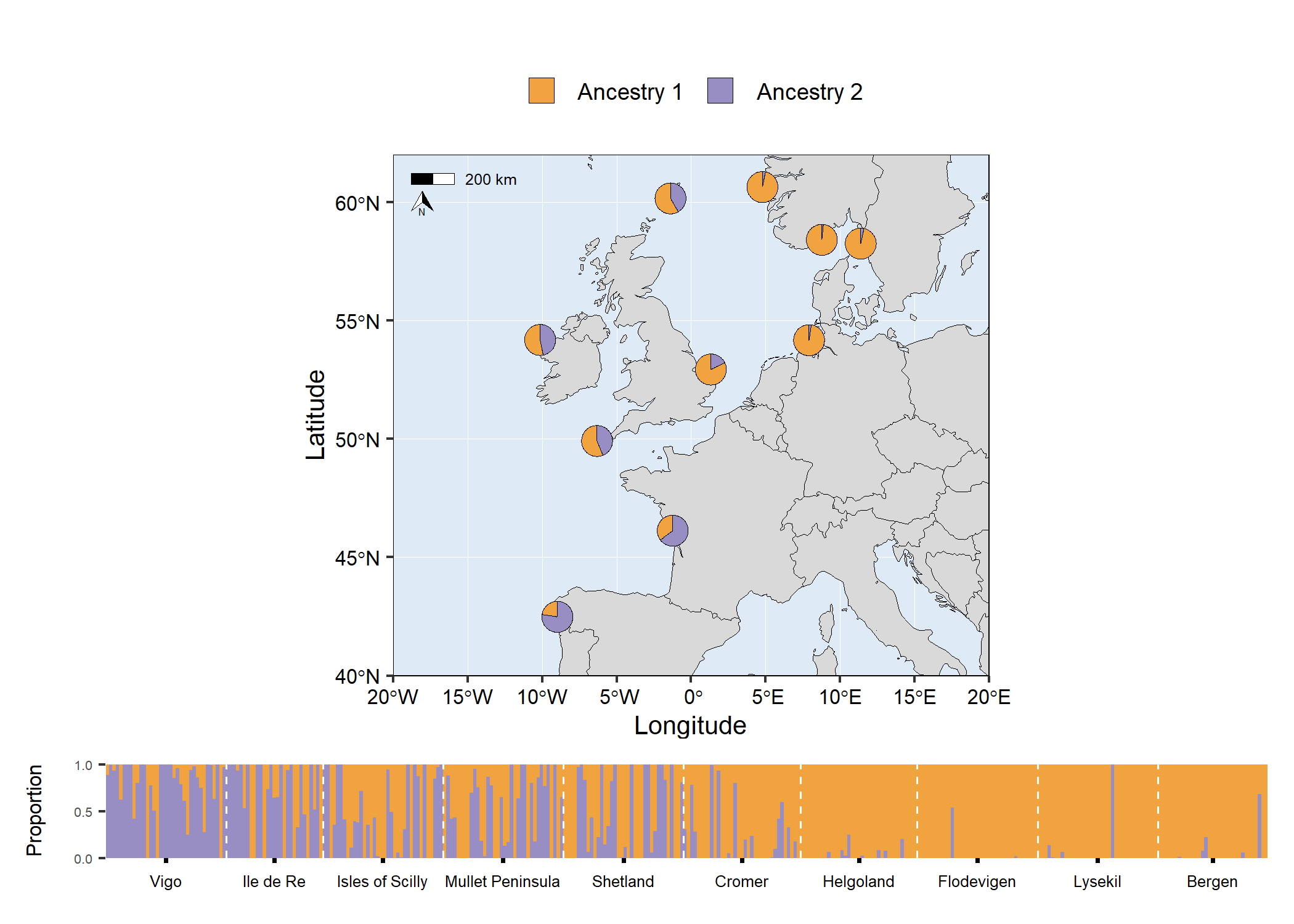
Code
# Load packages
library(mapmixture)
library(ggplot2)
library(gridExtra)
# Read in admixture file format 1
file <- system.file("extdata", "admixture1.csv", package = "mapmixture")
admixture1 <- read.csv(file)
# Read in coordinates file
file <- system.file("extdata", "coordinates.csv", package = "mapmixture")
coordinates <- read.csv(file)
# Run mapmixture
map6 <- mapmixture(
admixture_df = admixture1,
coords_df = coordinates,
cluster_cols = c("#f1a340","#998ec3"),
cluster_names = c("Ancestry 1","Ancestry 2"),
crs = 4326,
boundary = c(xmin=-20, xmax=20, ymin=40, ymax=62),
pie_size = 1.3,
)+
# Adjust theme options
theme(
legend.position = "top",
plot.margin = margin(l = 10, r = 10),
)+
# Adjust the size of the legend keys
guides(fill = guide_legend(override.aes = list(size = 5, alpha = 1)))
# Facet structure barplot
facet_barplot <- structure_plot(admixture1,
type = "facet",
cluster_cols = c("#f1a340","#998ec3"),
facet_col = 2,
ylabel = "Admixture proportions",
)+
theme(
axis.title.y = element_text(size = 10),
axis.text.y = element_text(size = 5),
strip.text = element_text(size = 6, vjust = 1, margin = margin(t=1.5, r=0, b=1.5, l=0)),
)
# Arrange plots
# grid.arrange(map6, facet_barplot, ncol = 2, widths = c(3,2))
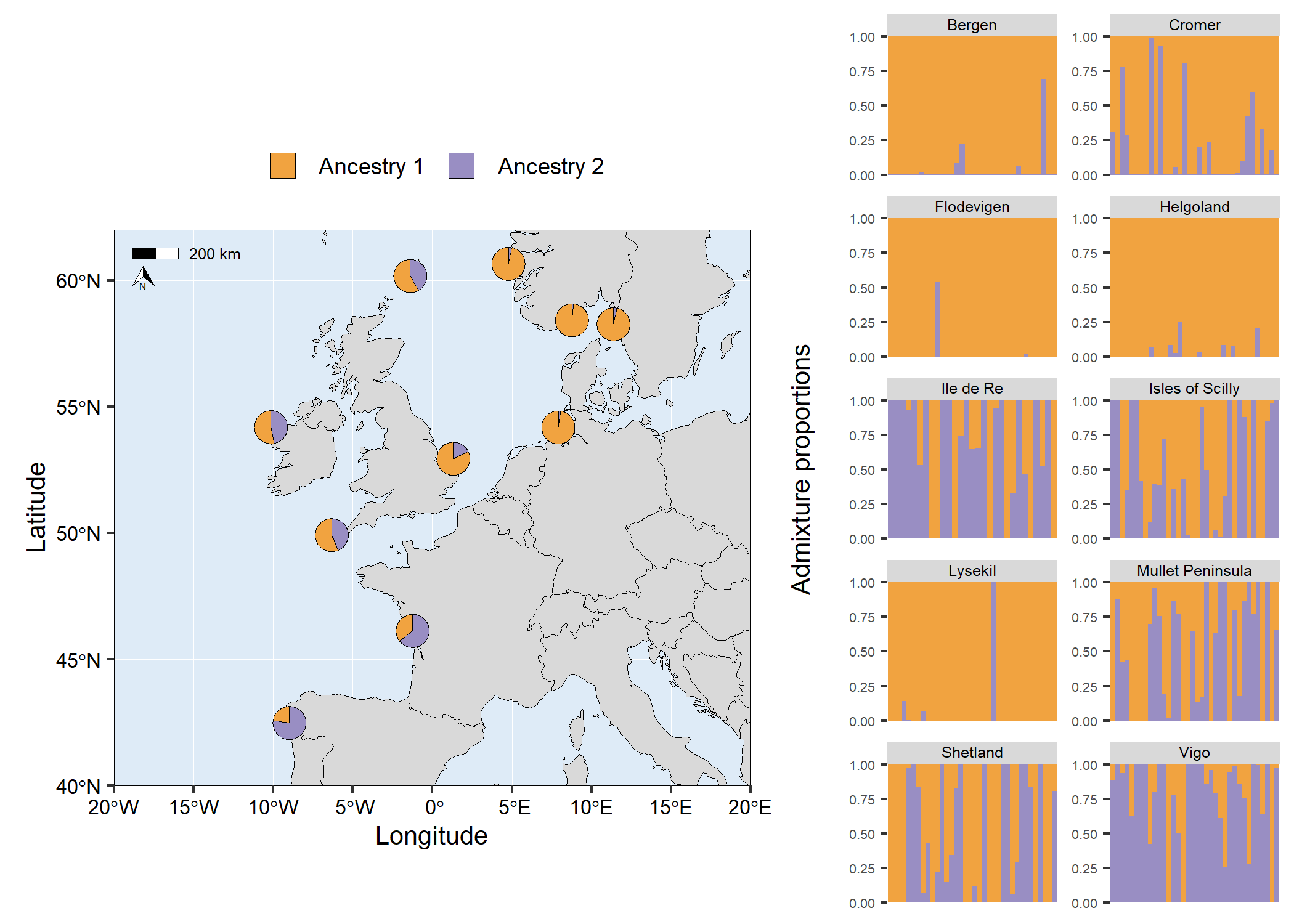
Use a raster as the basemap
The raster (TIFF) used in the example below was downloaded from Natural Earth here. You need to install the terra package to use this feature. Currently, the basemap argument accepts a SpatRaster or a sf object.
Code
# Load packages
library(mapmixture)
library(terra)
# Create SpatRaster object
earth <- terra::rast("../NE1_50M_SR_W/NE1_50M_SR_W.tif")
# Read in admixture file format 1
file <- system.file("extdata", "admixture1.csv", package = "mapmixture")
admixture1 <- read.csv(file)
# Read in coordinates file
file <- system.file("extdata", "coordinates.csv", package = "mapmixture")
coordinates <- read.csv(file)
# Run mapmixture
map7 <- mapmixture(admixture1, coordinates, crs = 3035, basemap = earth)
# map7
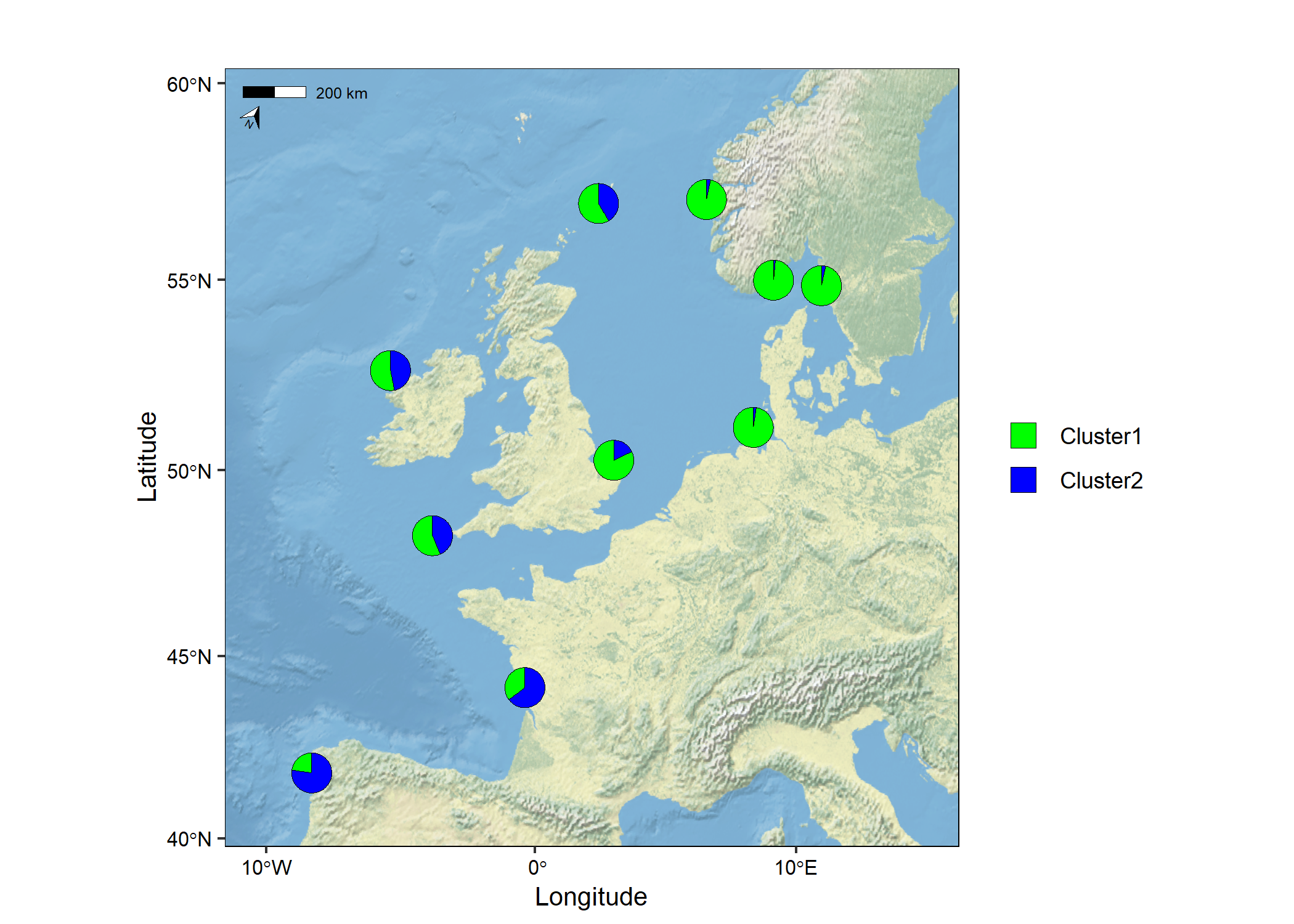
Add pie charts to an existing map
The vector data (shapefile) used in the example below was downloaded from the Natural England Open Data Geoportal here.
Code
# Load packages
library(mapmixture)
library(rnaturalearthhires)
library(ggplot2)
library(dplyr)
library(sf)
# Read in admixture file format 1
file <- system.file("extdata", "admixture1.csv", package = "mapmixture")
admixture1 <- read.csv(file)
# Read in coordinates file
file <- system.file("extdata", "coordinates.csv", package = "mapmixture")
coordinates <- read.csv(file)
# Parameters
crs <- 3035
boundary <- c(xmin=-11, xmax=13, ymin=50, ymax=60) |> transform_bbox(bbox = _, crs)
# Read in world countries from Natural Earth and transform to CRS
world <- rnaturalearthhires::countries10[, c("geometry")]
world <- st_transform(world, crs = crs)
# Read in Marine Conservation Zones shapefile
# Extract polygons for Western Channel, Offshore Brighton and Swallow Sand
# Transform to CRS
mczs <- st_read("../Marine_Conservation_Zones_England/Marine_Conservation_Zones___Natural_England_and_JNCC.shp", quiet = TRUE) |>
dplyr::filter(.data = _, MCZ_NAME %in% c("Western Channel", "Offshore Brighton", "Swallow Sand")) |>
st_transform(x = _, crs = crs)
# Run mapmixture helper functions to prepare admixture and coordinates data
admixture_df <- standardise_data(admixture1, type = "admixture") |> transform_admix_data(data = _)
coords_df <- standardise_data(coordinates, type = "coordinates")
admix_coords <- merge_coords_data(coords_df, admixture_df) |> transform_df_coords(df = _, crs = crs)
# Plot map and add pie charts
map8 <- ggplot()+
geom_sf(data = world, colour = "black", fill = "#d9d9d9", size = 0.1)+
geom_sf(data = mczs, aes(fill = "MCZs"), linewidth = 0.3)+
scale_fill_manual(values = c("yellow"))+
coord_sf(
xlim = c(boundary[["xmin"]], boundary[["xmax"]]),
ylim = c(boundary[["ymin"]], boundary[["ymax"]])
)+
add_pie_charts(admix_coords,
admix_columns = 4:ncol(admix_coords),
lat_column = "lat",
lon_column = "lon",
pie_colours = c("green","blue"),
border = 0.3,
opacity = 1,
pie_size = 0.8
)+
theme(
legend.title = element_blank(),
)
# map8
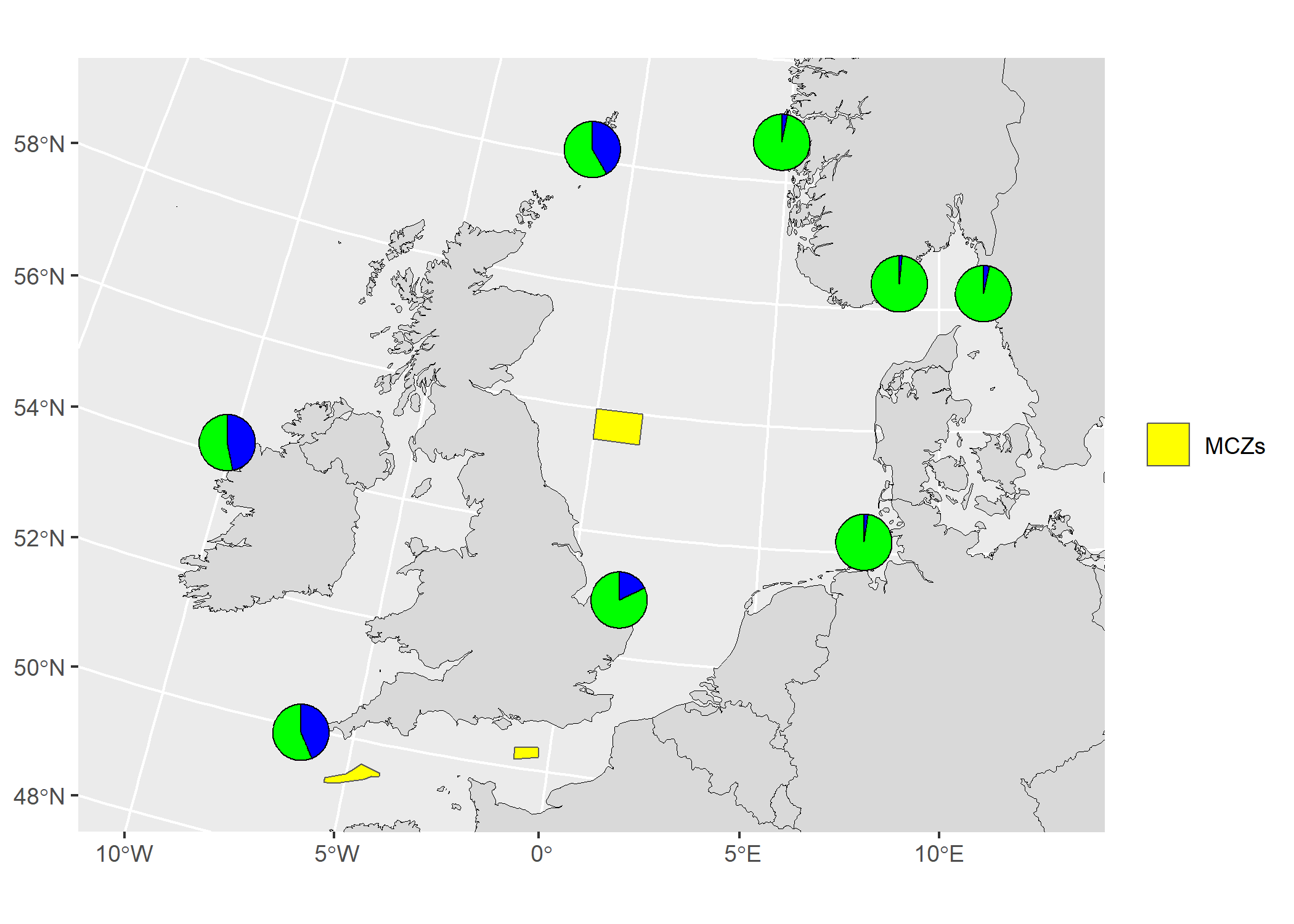
Scatter plot of PCA or DAPC results from genotypes
Code
# Load packages
library(mapmixture)
library(ggplot2)
library(adegenet)
library(RColorBrewer)
library(gridExtra)
# Load example genotypes
data("dapcIllus")
geno = dapcIllus$a
# Change population labels
popNames(geno) = c("Pop1","Pop2","Pop3","Pop4","Pop5","Pop6")
# Region names
region_names <- rep(c("Region1", "Region2"), each = 300)
# Define colour palette
cols = brewer.pal(nPop(geno), "RdYlBu")
# Perform PCA
pca1 = dudi.pca(geno, scannf = FALSE, nf = 3)
# Percent of genetic variance explained by each axis
percent = round(pca1$eig/sum(pca1$eig)*100, digits = 1)
# Scatter plot with centroids and segments
scatter1 <- scatter_plot(
dataframe = pca1$li,
group_ids = geno$pop,
type = "points",
axes = c(1,2),
percent = percent,
colours = cols,
point_size = 2,
point_type = 21,
centroid_size = 2,
stroke = 0.1,
plot_title = "PCA coloured by group_ids"
)+
theme(
legend.position = "none",
axis.title = element_text(size = 8),
axis.text = element_text(size = 6),
plot.title = element_text(size = 10),
)
# Same as scatter1 but no segments and axis 1 and 3 are shown
scatter2 <- scatter_plot(
dataframe = pca1$li,
group_ids = geno$pop,
type = "points",
axes = c(1,3),
percent = percent,
colours = cols,
point_size = 2,
point_type = 21,
centroids = TRUE,
centroid_size = 2,
segments = FALSE,
stroke = 0.1,
plot_title = "PCA no segments and axis 1 and 3 shown"
)+
theme(
legend.position = "none",
axis.title = element_text(size = 8),
axis.text = element_text(size = 6),
plot.title = element_text(size = 10),
)
# Same as scatter1 but coloured by region
scatter3 <- scatter_plot(
dataframe = pca1$li,
group_ids = geno$pop,
other_group = region_names,
type = "points",
axes = c(1,2),
percent = percent,
colours = cols,
point_size = 2,
point_type = 21,
centroid_size = 2,
stroke = 0.1,
plot_title = "PCA coloured by other_group"
)+
theme(
legend.position = "none",
axis.title = element_text(size = 8),
axis.text = element_text(size = 6),
plot.title = element_text(size = 10),
)
# Scatter plot with labels instead of points
scatter4 <- scatter_plot(
dataframe = pca1$li,
group_ids = geno$pop,
type = "labels",
labels = rownames(pca1$li),
colours = cols,
size = 2,
label.size = 0.10,
label.padding = unit(0.10, "lines"),
plot_title = "PCA using labels instead of points"
)+
theme(
legend.position = "none",
axis.title = element_text(size = 8),
axis.text = element_text(size = 6),
plot.title = element_text(size = 10),
)
# Arrange plots
# grid.arrange(scatter1, scatter2, scatter3, scatter4)
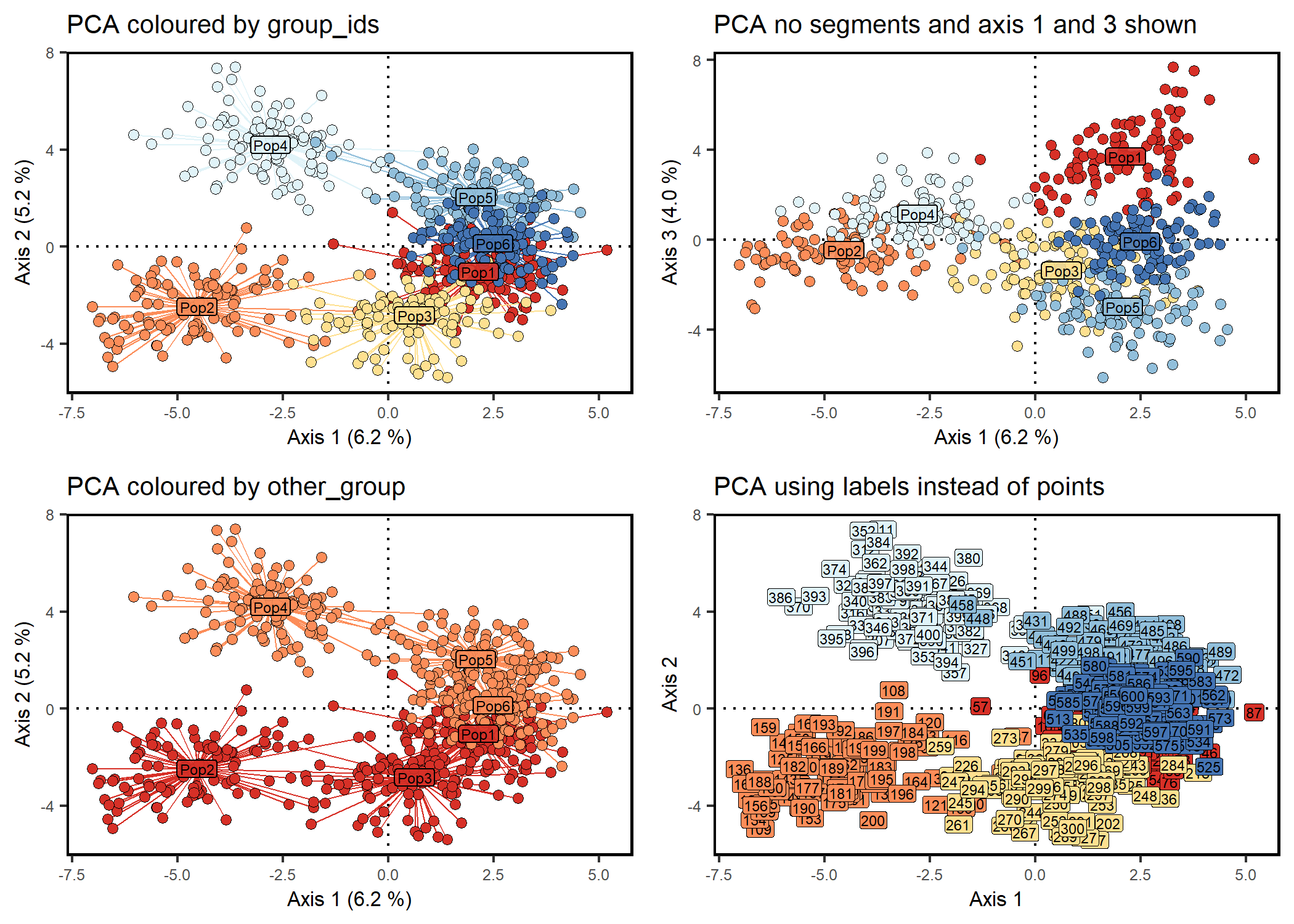
Launch interactive Shiny app
# Load package
library(mapmixture)
# Launch Shiny app
launch_mapmixture()
# Tested with the following package versions:
# shiny v1.8.0 (important)
# shinyFeedback v0.4.0
# shinyjs v2.1.0
# shinyWidgets 0.8.4
# bslib 0.7.0
# colourpicker 1.3.0
# htmltools v0.5.8.1
# waiter 0.2.5
Link to online Shiny app
https://tomjenkins.shinyapps.io/mapmixture/
Format
# Load package
library(mapmixture)
# Admixture Format 1
file <- system.file("extdata", "admixture1.csv", package = "mapmixture")
admixture1 <- read.csv(file)
head(admixture1)
#> Site Ind Cluster1 Cluster2
#> 1 Bergen Ber01 0.9999 1e-04
#> 2 Bergen Ber02 0.9999 1e-04
#> 3 Bergen Ber03 0.9999 1e-04
#> 4 Bergen Ber04 0.9999 1e-04
#> 5 Bergen Ber05 0.9999 1e-04
#> 6 Bergen Ber06 0.9999 1e-04
# Admixture Format 2
file <- system.file("extdata", "admixture2.csv", package = "mapmixture")
admixture2 <- read.csv(file)
admixture2
#> Site Ind Cluster1 Cluster2
#> 1 Bergen Bergen 0.9675212 0.03247879
#> 2 Cromer Cromer 0.8217114 0.17828857
#> 3 Flodevigen Flodevigen 0.9843806 0.01561944
#> 4 Helgoland Helgoland 0.9761543 0.02384571
#> 5 Ile de Re Ile de Re 0.3529000 0.64710000
#> 6 Isles of Scilly Isles of Scilly 0.5632444 0.43675556
#> 7 Lysekil Lysekil 0.9661722 0.03382778
#> 8 Mullet Peninsula Mullet Peninsula 0.5316833 0.46831667
#> 9 Shetland Shetland 0.5838028 0.41619722
#> 10 Vigo Vigo 0.2268444 0.77315556
# Admixture Format 3
file <- system.file("extdata", "admixture3.csv", package = "mapmixture")
admixture3 <- read.csv(file)
admixture3
#> Site Ind Cluster1 Cluster2
#> 1 Bergen Bergen 1 0
#> 2 Cromer Cromer 1 0
#> 3 Flodevigen Flodevigen 1 0
#> 4 Helgoland Helgoland 1 0
#> 5 Ile de Re Ile de Re 0 1
#> 6 Isles of Scilly Isles of Scilly 1 0
#> 7 Lysekil Lysekil 1 0
#> 8 Mullet Peninsula Mullet Peninsula 1 0
#> 9 Shetland Shetland 1 0
#> 10 Vigo Vigo 0 1
# Coordinates
file <- system.file("extdata", "coordinates.csv", package = "mapmixture")
coordinates <- read.csv(file)
coordinates
#> Site Lat Lon
#> 1 Bergen 60.65 4.77
#> 2 Cromer 52.94 1.31
#> 3 Flodevigen 58.42 8.76
#> 4 Helgoland 54.18 7.90
#> 5 Ile de Re 46.13 -1.25
#> 6 Isles of Scilly 49.92 -6.33
#> 7 Lysekil 58.26 11.37
#> 8 Mullet Peninsula 54.19 -10.15
#> 9 Shetland 60.17 -1.40
#> 10 Vigo 42.49 -8.99
